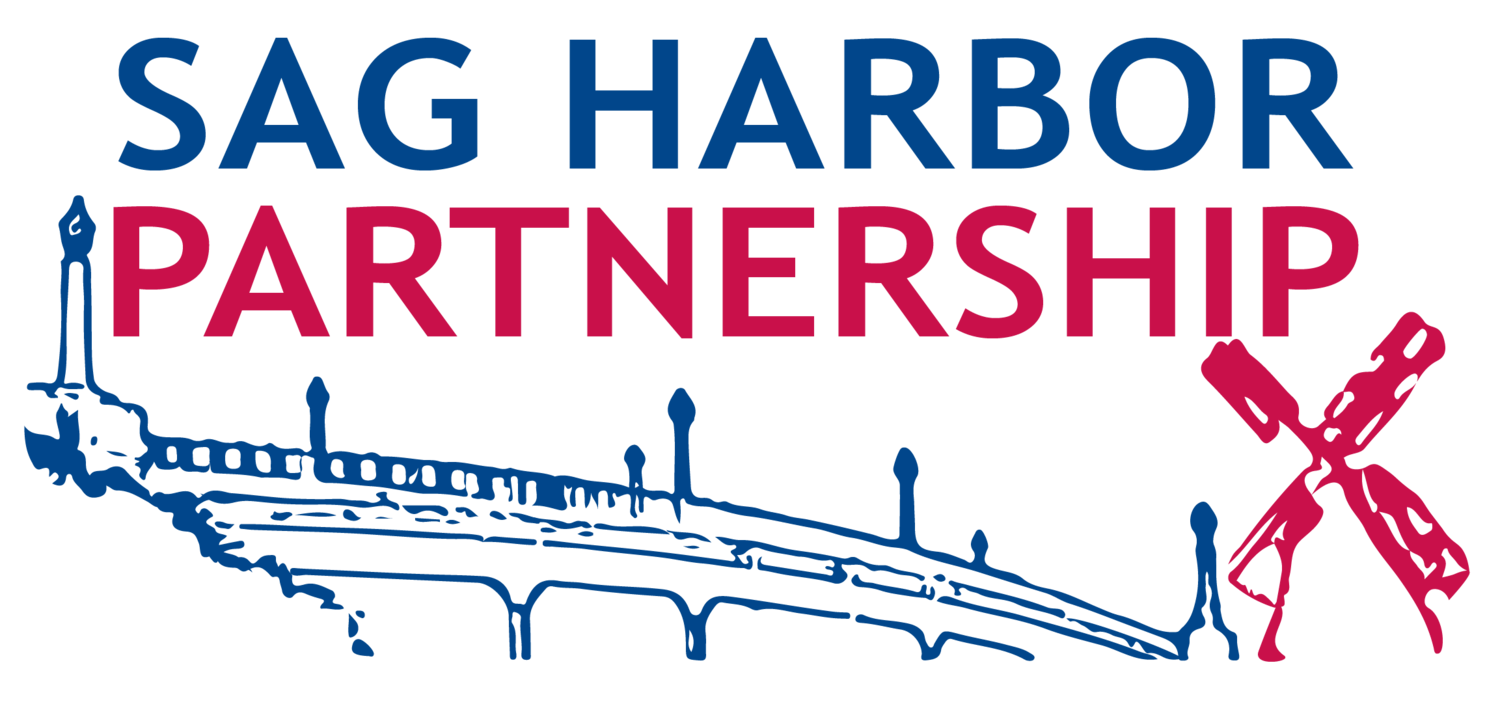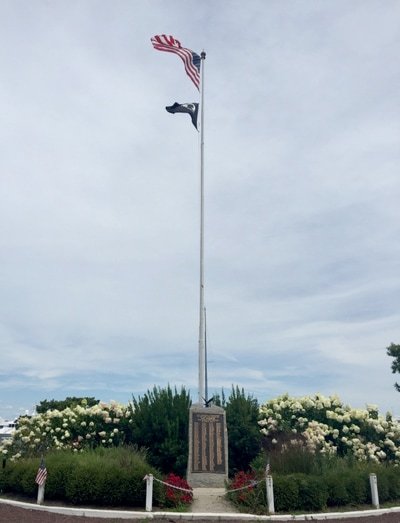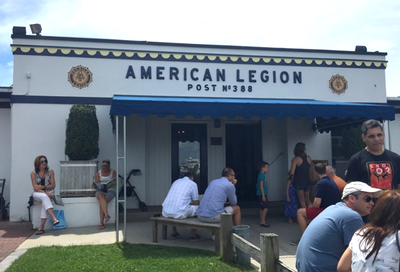SAG HARBOR IN WARTIME
Sag Harbor has sent sons and daughters to every war since the American Revolution, and this Tour commemorates them and their service. From the extraordinary courage and strategy shown in the Battle of Sag Harbor (1777) to Sag Harbor’s participation in the Iraq War, our soldiers have exemplified selflessness and bravery necessary in times of strife. We honor those who have served our country.
.
The Old Burying Ground: Occupation
The Old Burying Ground was one of the first grave sites in Sag Harbor, and ten years before Meigs' Raid, the British cleared trees here, horrifying residents at their lack of respect, and set up camp to defend the port, it being the highest available ground. They also occupied the "Umbrella House", thought to be the oldest house in Sag Harbor, still located at Division and Burke Streets.
There had been a succession of discouraging losses in the Revolutionary War before Lt. Colonel Return Jonathan Meigs devised a plan to take the British stronghold at Sag Harbor. Without any official authorization, he organized a battle that became a turning point in the war, using impressive invention and courage, and the Old Burying Ground was key to its success. The Old Burying Ground is located just behind the Old Whalers’ Church at 44 Union St.
You will find many graves at the marked with 1776 here, honoring men who fought in the Revolution.
Old Burying Ground by Old Whalers’
Revolutionary War Grave
Old Burying Ground Vista *
.
Meig’s Raid: Revolution
Meigs' Raid, or the Battle of Sag Harbor, took place on May 23, 1777.
Lt. Colonel Return Jonathan Meigs (1740-1823) left Connecticut in the dead of night with 243 men in 13 whaleboats, and stole across the Sound. They arrived on the North Fork, carried their boats south across it, and made it to Long Beach, Sag Harbor, where they quietly hauled up. They then took off on foot for the British camp and a surprise attack.
A member of their attack force, Christopher Vail, made an account of the attack, writing:
“We proceed down to their quarters where we completely succeeded in capturing the whole force except one man. We burnt all the coasting vessels, which were all loaded and laid alongside the wharf, and a store [of weapons] that was 60 feet long that stood on the wharf.
“The British soldiers had just gotten their pay and many had been eating and drinking heavily. They remained, went drinking etc., and all got pretty well boozy. When we arrived we took 99 Tories. Some had nothing but his shirt on, some a pair of trowsers, others perhaps 1 stocking and one shoe and in fact they were carried off in their situation to New Haven.”
Not one person was killed, but the explosion and fire wiped out the entire British encampment.
It should be noted that Meigs undertook to rid Sag Harbor of the British at a time of discouragement in the revolution. The battle was thought to be a turning point, returning momentum to the Revolution. From George Washington, we have the following letter:
Headq’trs, Middletown, May 29, 1777
Dear Sir:
I am just now favored with your letter of the 25th, by Major Humphry. The intelligence communicated by it is truly interesting and agreeable. And now I shall take occasion, not only to give you my hearty approbation of your conduct in planning the expediction [sic] to Long Island, but to return my sincere thanks to Lieut. Col. Meigs and all the officers and men engaged in it.
The enterprise, so fortunate in the execution, will greatly distress the enemy in the important and essential article of forage, and reflects much honor upon those who performed it. I shall ever be happy to reward merit when in my power, and therefore wish for you to enquire for a vacant ensigncy for Sergeant Jennings, to which you will promote him, advising me of the same and the time.
I am. Sir, &c.,
G. Washington
This classic American feat of ingenuity and courage is commemorated by Meig's Monument, and there have been occasional re-enactments of the Raid by locals ever since. The Monument just east of 44 Union Street.
Lt. Colonel Return Jonathan Meigs
Meigs’ Monument Near Old Whalers’ ‡
Reenactment of Meigs’ Raid *
The First Stars and Stripes
The First Stars and Stripes
John Hulbert (1738-1813)’s first house in Sag Harbor was at 8 Union Street. His family had a saddle business. The house was later owned by Stephen French. Hannibal, Stephen & Smith French were three brothers, who incidentally owned the last whaling ship, called the Myra, that sailed from Sag Harbor. Besides their prosperous whaling interests, they also owned the first steamship to leave the village. Stephen's old college friend became President Chester A. Arthur, who was a frequent summer visitor, and the house became known as the Summer White House.
Hulbert later owned a house at 241 Main, which became known officially as the Hulbert House. Hulbert was the first to come up with the prototype of our American flag that included stars and stripes, before which there was no representative American flag. This flag (pictured) was taken with Hulbert’s militia, under the command of General Benedict Arnold, into battle, including the battle of Fort Ticonderoga in 1775. When Hulbert eventually reached Philadelphia he was carrying it. Hulbert died penniless in upstate NY, and a Sag Harbor resident aided him financially for the last several years before his death.
The original flag designed by Hulbert is in the Suffolk County Historical Society Museum in Riverhead.
Hulbert’s Flag †
Plaque at House Commemorating Hulbert’s Design ¶
Hulbert’s House ¶
The Civil War
Lyman Beecher, ardent abolitionist, Catholic-hater, and father of Harriet Beecher Stowe, (Harriet being the author of Uncle Tom's Cabin and credited by Lincoln as "the little woman who wrote the book that made this great war”), regularly stayed at the John Jermain house in Sag Harbor when he came here to preach.
Democratic candidate George McClellan, running against Lincoln for the presidency, vacationed in Sag Harbor and East Hampton in August 1863, and was seemingly well-liked in the area, which generally voted Democratic at that time. But when the votes were tallied in East Hampton in the 1864 election, Lincoln had beat McClellan by eight votes.
Local men who returned from the Civil War were given a dinner at Sag Harbor’s Washington Hall on July 4th, 1865. Members of the veterans’ group, the Grand Army of the Republic, remained active in Sag Harbor for decades and arranged for Sag Harbor’s Civil War Memorial, located at the corner of Main and Madison Streets, which was dedicated on October 4, 1896. Their chapter was known as the Edwin Rose Post No. 274.
The Historic Division of the Southampton Town Clerk describes the memorial as:
A small, triangular park surrounded by a low Victorian fence at the intersection of Main and Madison Streets contains a tall, salt-and-pepper granite Civil War Monument erected to the memory of “the brave men who from Sag Harbor bore some loyal part in the great Civil War.” The monument is surrounded by small piles of cannon balls and a mortar. In 1988, a large iron urn was dedicated by the Sag Harbor Historical Society to the memory of Josephine O’Halloran Bassett (1903-1985), a long time member of the Olde Sagg Harbour Committee which worked for many years to preserve village landmarks and history prior to the creation of the historic district.
The Former Sag Harbor Granary *
Bliss-Leavitt Torpedoes Being Loaded and Tested
The Great War Memorial at Otter Pond
The Great War Memorial at Otter Pond
The Great War Memorial is sited for maximum visibility at the corner of Jermain and Main Streets.
The monument was erected after World War I, when the community decided it wanted a monument to honor those who had served. A massive rock was found on the Spring Farm property off Stoney Hill. It took two teams of horses, pulling a sled, to drag it into place, after which the bronze plaque was affixed honoring those who "served in the Great War and in memory of those who gave their lives".
Plaque and Eagle on Memorial
Great War Memorial at Otter Pond ¶
Sag Harbor’s World War II Veterans
Interestingly, the rock for the plaque on this memorial came from the NY Subway system by way of the breakwater, near the site of the Memorial itself at Marine Park, and was dragged into place in 1995.
John Ward, for whom the landmark Sag Harbor Windmill is named, was a former Sag Harbor Trustee and later Mayor. It was he who arranged for the rock to be placed here to honor the 446 veterans of WWII from our area, of whom 18 native sons from Sag Harbor gave their lives.
The plaque lists all the men & women from Sag Harbor, Noyac and North Haven who served in the war, probably comprising 10 percent of the population at that time.
One of these, Lt. Arthur Browngardt, served in a B-25 J Bomber called the “Sag Harbor Express”. A small plaque on the fire house commemorates his heroic death in that plane over the Philippines on Jan 7, 1945. The plane was shot down and crashed into Luzon Cathedral, and an inscription on a plaque at the cathedral reads:
“AT 9:30 am. ON 07 JAN. 1945, A NORTH AMERICAN MITCHELL B-25 J BOMBER No.11-43-36 “SAG HARBOR EXPRESS; PLOWED THROUGH THE ROOF OF THIS CHURCH AFTER IT WAS HIT BY JAPANESE FLAK AS IT WAS BOMBING CLARK FIELD DURING AN ALL-OUT 5TH AIR FORCE ATTACK. IT MADE A GAPING LARGE HOLE ON THE ROOF, LEAVING ITS LEFT WING CAUGHT AMONG THE CEILING RAFTERS. IT THEN CRASHED TO PIECES AND INTO A HUGE FIREBALL ON THE PATIO OF THE HOLY ANGEL ACADEMY NEARBY, KILLING THE ENTIRE CREW. THE PILOT AND CO-PILOT WERE THROWN CLEAR OUT OF THE AIRCRAFT UPON IMPACT WHILE THE REST WERE EITHER MANGLES, PARTIALLY BURNED OR CHARRED BEYOND RECOGNITION. JAPANESE TROOPS BILLETED IN THE SAID ACADEMY RUSHED OUT IN PANIC WITH THEIR RIFLES AND FIRED VOLLEYS AT THE FLAMMING WRECKAGE. LATER THE JAPANESE GATHERED THE CADAVERS AND ARRANGED THEM SIDE BY SIDE, WITH THEIR PERSONAL EFFECTS PLACED ATOP THEIR CHESTS. THE THEN PARISH PRIEST OF ANGELES REV.FR.COSME BITUIN WAS ALLOWED TO CONDUCT LAST RITES. THE JAPANESE BURIED THE BODIES IN A SHALLOW GRAVE ABOUT 200 YARDS SOUTH OF THE WRECKAGE. IN FEB. 1945 AFTER THE LIBERATION OF ANGELES, A U.S.ARMY GRAVEYARD UNIT EXHUMED THE REMAINS AND WERE SHIPPED BACK TO THE U.S.A. FOR PERMANENT INTERMENT. THE BOMBER CREW BELONGED TO THE 499TH BOMB SQDN. NAMED “ BATS OUTA HELL” 345TH BOMBARDMENT GROUP NAMED “AIR APACHES” FIFTH AIR FORCE, U.S. ARMY
THE CREW OF THE B-25 “SAG HARBOR EXPRESS WERE:
2ND LT. ARTHUR BROWNGARDT
PILOT – SAG HARBOR, LONG ISLAND, NEW, YORK
2ND LT. JACK B. BARTLOW
CO-PILOT – 8624 WOODBRIDGE, CINCINNATI, OHIO
2ND LT. HOWARD C. LEBECK
NAVIGATOR – 93 E. SCHLEY BLVD., BREMERTON, WASH.
T/SGT. WILLIAM H. NOE
ENGINEER-GUNNER – ADDRESS UNKNOWN
T/SGT. CLARENCE H. GILBERT
RADIOMAN-GUNNER – ADDRESS UNKNOWN
S/SGT. ENGLEHARDT VON HEBEL
GUNNER – ADDRESS UNKNOWN”
The Heroism of Lance Cpl Jordan C. Haerter in Iraq
The Lance Cpl. Jordan C. Haerter Veterans Memorial Bridge commemorates Sag Harbor native Jordan Haerter (1988-2008), who was tragically killed by a vehicle-borne Improvised Explosive Device in Ramadi, Iraq on the 22nd of April, 2008. He has subsequently been awarded the Navy Cross for extraordinary heroism for saving the lives of 33 United States Marines and over 20 Iraqi Police.
A memorial foundation, Jordan’s Initiative, has been established in his honor by Jordan's father, Chris Haerter, and his partner Michelle Severance. A memorial foundation "In Jordan's Honor, Ltd.", was established by Jordan's mother, JoAnn Lyles.
President Barack Obama, in a speech given at Camp Lejeune in 2009, said of the heroism shown by Haerter and Jonathan Yale, standing guard with him at the time of their sacrifice:
"‘Semper Fidelis’—it means always being faithful to Corps, and to country, and to the memory of fallen comrades like Corporal Jonathan Yale and Lance Corporal Jordan Haerter. These young men enlisted in a time of war, knowing they would face great danger. They came here, to Camp Lejeune, as they trained for their mission. And last April, they were standing guard in Anbar. In an age when suicide is a weapon, they were suddenly faced with an oncoming truck filled with explosives.
"These two Marines stood their ground. These two Marines opened fire. And these two Marines stopped that truck. When the thousands of pounds of explosives detonated, they had saved 50 Marines and Iraqi police who would have been in the truck’s path, but Corporal Yale and Lance Corporal Haerter lost their own lives. Jonathan was 21. Jordan was 19.
“In the town where Jordan Haerter was from, a bridge was dedicated in his name. One Marine who traveled to the ceremony said: ‘We flew here from all over the country to pay tribute to our friend Jordan, who risked his life to save us. We wouldn’t be here without him.' "
L. Cpl. Jordan Haerter in Iraq
Dedication of Bridge ‡
View of Bridge ¶
Plaque
The VFW and the American Legion in Sag Harbor
The Chelberg & Battle American Legion Post 388, Sag Harbor, located at 26 Bay Street, hosts the Veterans of Foreign Wars Post 9082 at 7:00pm the third Monday of every month.
One notable woman who was a 65-year member of this post was Dolores Mulvihill Zebrowsi. She was commissioned into the Army Nurse Corps in March 1945, and was assigned to the 1247th Hospital Train Unit, responsible for transporting groups of injured and sick soldiers returning from both the European and Pacific theatres to hospitals near their homes. Her service was recognized by the award of the American Theatre of Operations Campaign Medal and the World War II Victory Medal, and more recently, the New York State Medal for Merit. The 1247th was also awarded a Meritorious Unit Citation during this period. Of her wartime service, which often required her to be the lone night-duty nurse on the hospital train, Ms. Zebrowski said in a 2007 interview, “I looked forward to it, because I like excitement and I felt a duty to go. Right now, if I could be young again, I’d be at the big hospital in Germany where all the Iraq injured are sent.”
These two fine institutions help sponsor the Annual Sag Harbor Memorial Day Parade, and the American Legion Post 388, Sag Harbor, erected a memorial at the St. David AME Zion Cemetery, dedicated to local veteran Frank V. Onisko, which reads:
In Memory of Those Who Served Their Country
Donated & Erected by American Legion Post 388
Sag Harbor, New York
Dedicated in Memory of Frank V. Onisko
Nov. 11, 2006
American Legion in Sag Harbor, Bridge Salute
Wall Memorial at the American Legion Post 388 ¶
Memorial to Veterans of Vietnam War
Memorial to Operation Enduring Freedom
Memorial Day Parade, Sag Harbor



























